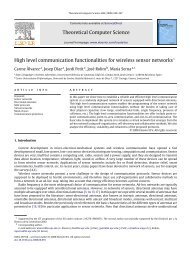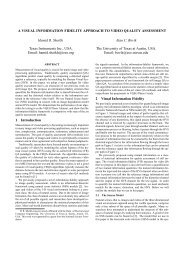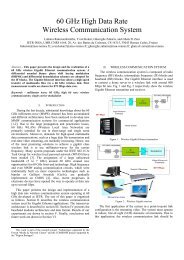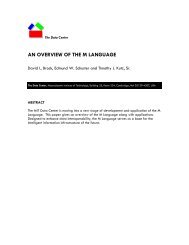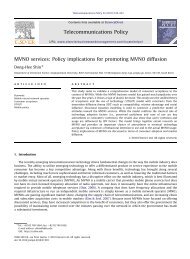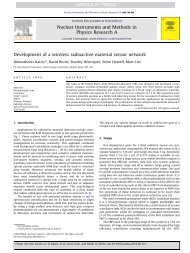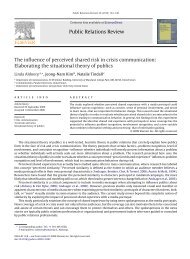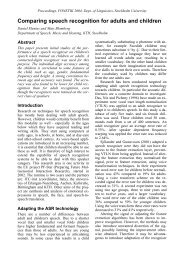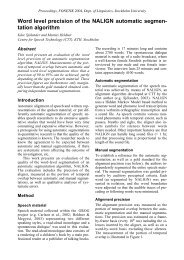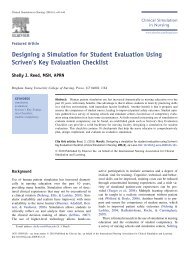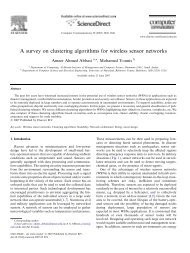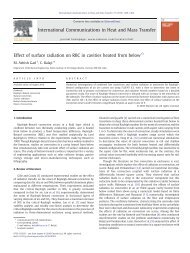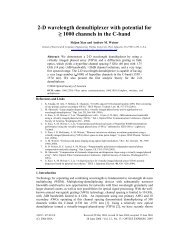Offline handwritten Arabic cursive text recognition using Hidden ...
Offline handwritten Arabic cursive text recognition using Hidden ...
Offline handwritten Arabic cursive text recognition using Hidden ...
You also want an ePaper? Increase the reach of your titles
YUMPU automatically turns print PDFs into web optimized ePapers that Google loves.
1084 J.H AlKhateeb et al. / Pattern Recognition Letters 32 (2011) 1081–1088<br />
removal, thinning and baseline estimation as well as segmentation<br />
of words, subwords and even characters.<br />
Although separate words have been manually segmented and<br />
binarized in the IFN/ENIT database (Pechwitz et al., 2002), we have<br />
investigated how to generally detect the baseline and also segment<br />
words from scanned <strong>handwritten</strong> <strong>text</strong>s <strong>using</strong> knowledge-based<br />
statistical models. Firstly, we project a given image to the vertical<br />
axis, and calculate the sum of pixels accordingly. The baseline is<br />
then determined as the one of the peak value in the projected signal.<br />
Since the baseline is located below the middle line, only the<br />
peak value in the bottom half part of the projected signal is used<br />
for its detection.<br />
After detection of the baseline, word and subword are segmented<br />
as follows. Firstly, the input image is projected to the horizontal<br />
axis to form a vertical histogram. Then, distances between<br />
each pair of non-zero bins in the histogram are extracted. If this<br />
distance is no less than a threshold dw, it refers to boundary of<br />
two words. Otherwise, if the distance is less than dw but larger than<br />
another smaller threshold ds, it is detected as boundary of subwords.<br />
The two thresholds dw and ds are optimally determined<br />
<strong>using</strong> Bayesian minimum classification error criteria, and further<br />
details can be found in (AlKhateeb et al., 2008, 2009b).<br />
In an ideal handwriting model, the word has to be written in a<br />
horizontal way with both ascenders and descenders aligned along<br />
the vertical direction. However, these conditions are rarely satisfied<br />
in real data. Therefore, normalization is essential to remove<br />
the variation in <strong>handwritten</strong> images for consistent analysis and<br />
measurement. Among many algorithms proposed for this purpose,<br />
the skeletonization technique is one of the most popular and likewise<br />
the normalization algorithm in (Pechwitz and Maergner,<br />
2003) has been employed in this research. A sample image in binary<br />
format is shown in Fig. 2(a), along with its normalized counterpart<br />
in Fig. 2(b).<br />
4.2. Feature extraction<br />
Feature extraction is to remove the redundancy from the data<br />
and gain a more effective representation of the word image by a<br />
set of numerical characteristics, i.e. extracting most essential information<br />
from raw images. According to (Madhvanath and Govindaraju,<br />
2001), features used in off-line <strong>recognition</strong> are classified<br />
into high level features which are extracted from the whole word<br />
image, medium level features which are extracted from the letters,<br />
(a) Original Binary image<br />
(b) Normalized Gray image<br />
(c) Mirror image<br />
and low level features which are extracted from sub-letters. Moreover,<br />
features can also be classified into structural and statistical<br />
ones. Structural features describe the topological and geometrical<br />
characteristics of a pattern, which include strokes, endpoints,<br />
loops, dots and their position related to the baseline. While statistical<br />
features are derived from statistical distribution of pixels and<br />
describing the characteristic measurements of a pattern, which include<br />
zoning, density distribution of pixels that counts the ones<br />
and zeros, moments (Lorigo and Govindaraju, 2006), etc.<br />
To cope with the characteristics that how <strong>Arabic</strong> <strong>text</strong>s are written,<br />
sliding windows/frames technique is widely used from right to<br />
left to extract features for off-line <strong>recognition</strong> (Husni et al., 2008).<br />
In this paper, the sliding window technique used in speech <strong>recognition</strong><br />
(Husni et al., 2008) has been adopted, yet applied to mirrored<br />
word image (MWI) after normalization in size to speed<br />
both training and testing process. For other features like discrete<br />
cosine transform (DCT) coefficients and moment invariants, please<br />
refer to our previous work in (Alkhateeb et al., 2009c,d).<br />
Starting from the first pixel of the word, a sliding window is applied<br />
to the MWI to calculate the number of non-background pixels.<br />
The horizontal sliding window has the same height of the word image,<br />
three pixels in width with one overlapped pixel. When the sliding<br />
window is moving from left to right, as shown in Fig. 3, each MWI<br />
is divided into fifteen uniform strips/frames horizontally. From<br />
these window strips, in total 30 features are extracted as follows.<br />
Firstly, the first fifteen features (F1 F15) are determined as<br />
average intensity of the pixels in each strip, i.e.<br />
Fi ¼ðAverage pixel intensity in the ith vertical areaÞji 2½1; 15Š:<br />
ð1Þ<br />
Then, average of these 15 features is used as the sixteenth feature<br />
F16, which denotes overall mean intensity of the whole word<br />
image.<br />
F16 ¼ X15<br />
,<br />
15: ð2Þ<br />
i¼1<br />
Fi<br />
Afterwards, the mean intensity of each consecutive pair of strips<br />
is extracted as fourteen additional features (F17 F30) as follows:<br />
Fiþ16 ¼ðFi þ Fiþ1Þ=2; i 2½1; 14Š: ð3Þ<br />
In addition, several structure-like features are also extracted<br />
including number of connected regions nr, number of connected<br />
regions (dots) below the baseline nb, and number of connected regions<br />
above the baseline na. These are called structure-like features<br />
as to some degree they represent topological structure of the image.<br />
How to use these features to refine recognized results in a<br />
combined scheme are described in details below.<br />
Fig. 2. A sample original binary image (a), normalized grey image (b), mirror image<br />
(c). Fig. 3. Regions used for feature extraction and sliding window.



